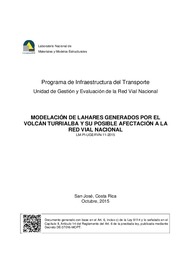Modelación de lahares generados por el Volcán Turrialba y su posible afectación a la red víal nacional

View/
Date
2015-10Author
Ruiz Cubillo, Paulo
Vega Salas, Paul
Barrantes Jiménez, Roy
Loría Salazar, Luis Guillermo
Metadata
Show full item recordAbstract
Existen tramos de rutas nacionales de gran importancia que bordean los flancos y zonas bajas del volcán Turrialba. Entre ellas están las rutas 32, 10, 230 y 218. La actividad del volcán Turrialba se ha incrementado paulatinamente desde el año 2007 hasta presentar erupciones freáticas con algún aporte magmático en el 2015. Anticipando un incremento aún mayor en la actividad volcánica del Turrialba combinada con una estación lluviosa fuerte y que se llegue a presentar una situación similar a la del volcán Irazú (1963 -1965), se identificaron cuáles son las zonas y puentes que podrían ser afectados por lahares, esto con el propósito de poder tomar medidas de prevención a tiempo y poder reducir la vulnerabilidad de estos sitios. La identificación de las posibles zonas que podrían ser afectadas por lahares se realizó mediante la utilización del software LAHARZ del USGS para modelar este tipo de eventos de forma rápida y oportuna. Se realizó un modelado simulando el mismo volumen de lahares que afectaron Taras en 1963-1965 distribuidos en tres eventos (2, 3 y 5 millones de m3) y disparados desde las zonas altas de diferentes cauces alrededor del Volcán Turrialba. Por último, se realizó un análisis específico para un lahar con volumen de 2 millones de m3 (evento con mayor posibilidad de ocurrir por tener una tamaño relativamente pequeño) en el que se incluye un rango de confiabilidad de 95% y en el que se evalúan tres posibles escenarios: 1- Conservador, 2- promedio y 3- el peor. Este trabajo representa un insumo para la Administración y podría ser utilizado por la Comisión Nacional de Prevención de Riesgos y Atención de Emergencias (CNE), así como por el Ministerio de Obras Públicas y Transportes (MOPT), con el fin de implementar medidas de mitigación en las estructuras de los puentes nuevos y la implementación de sistemas de monitoreo y alerta temprana en las partes altas de las cuencas. There are sections of national highways of great importance that are bordering the sides and lower areas of the Turrialba volcano. These include routes 32, 10, 230 and 218. The Turrialba volcano activity has gradually increased since 2007 to present phreatic eruptions with some magmatic contribution in 2015. Anticipating an even greater increase in the volcanic activity of the Turrialba combined with a strong rainy season and having a similar situation of the Irazu volcano (1963 -1965), were identified which areas and bridges could be affected by the lahars, this in order to be able to take preventive measures in time and to reduce the vulnerability of these sites. The identification of potential areas that could be affected by lahars was performed by using the LAHARZ software of the USGS to model such events quickly and timely. Modeling was performed by simulating the same volume of lahars that affected Taras in 1963-1965, distributed in three events (2, 3 and 5 million m3) and fired from the highlands of different channels around the Turrialba volcano. Finally, a specific analysis for a lahar with a volume of 2 million m3 was made (event most likely to occur by having a relatively small size) which includes a reliability range of 95% and in which are made tests of three possible scenarios: 1- Conservative, 2- average and 3- the worst. This report represents an input to the administration and could be used by the National Commission of Risk Prevention and Emergency Response (In Spanish, CNE) and the Ministry of Public Works and Transport (In Spanish, MOPT), in order to implement mitigation measures in the structures of the new bridges and implementation of monitoring and early warning in the upper parts of the basins.
Collections
- Informes [1102]
